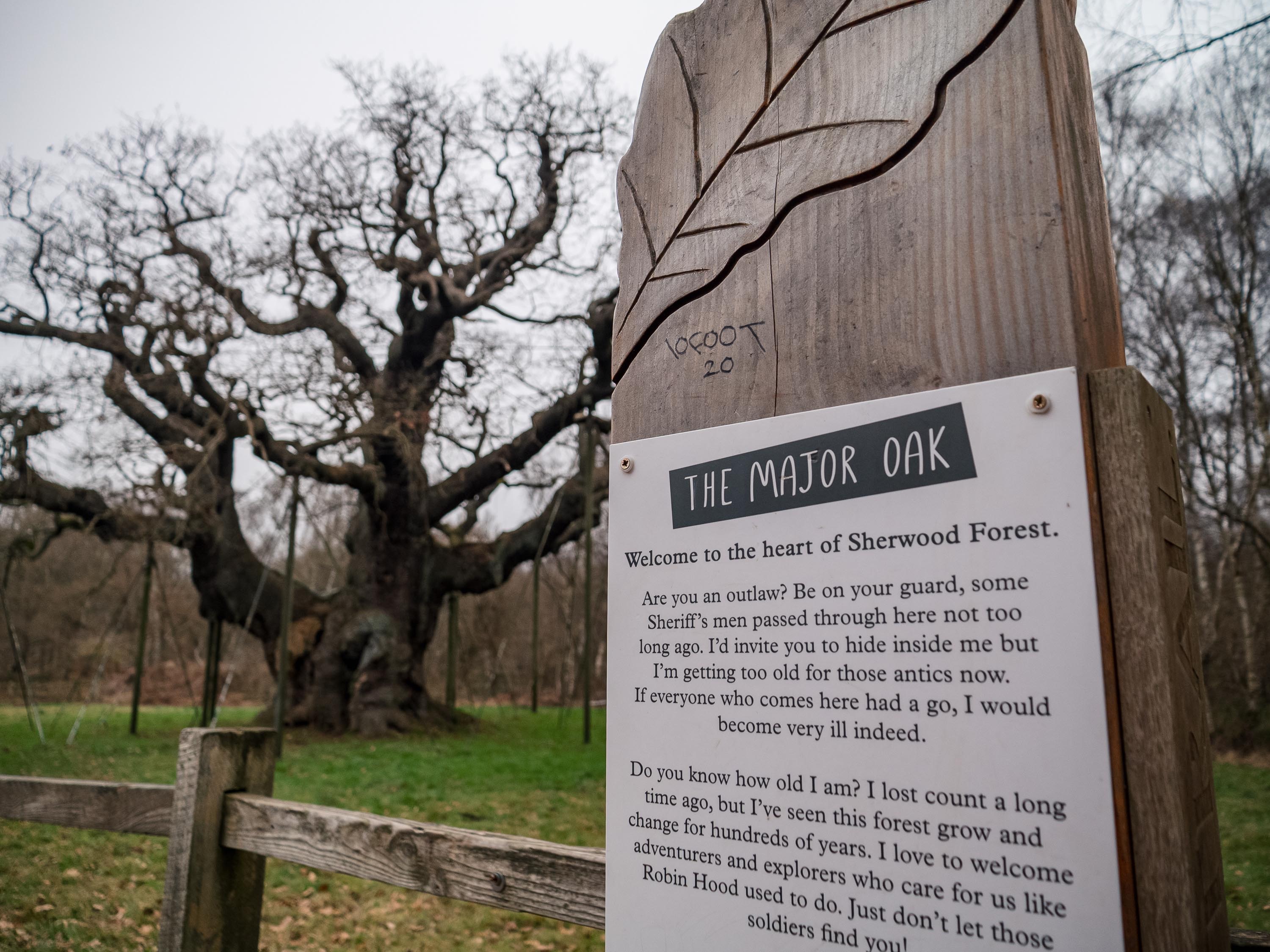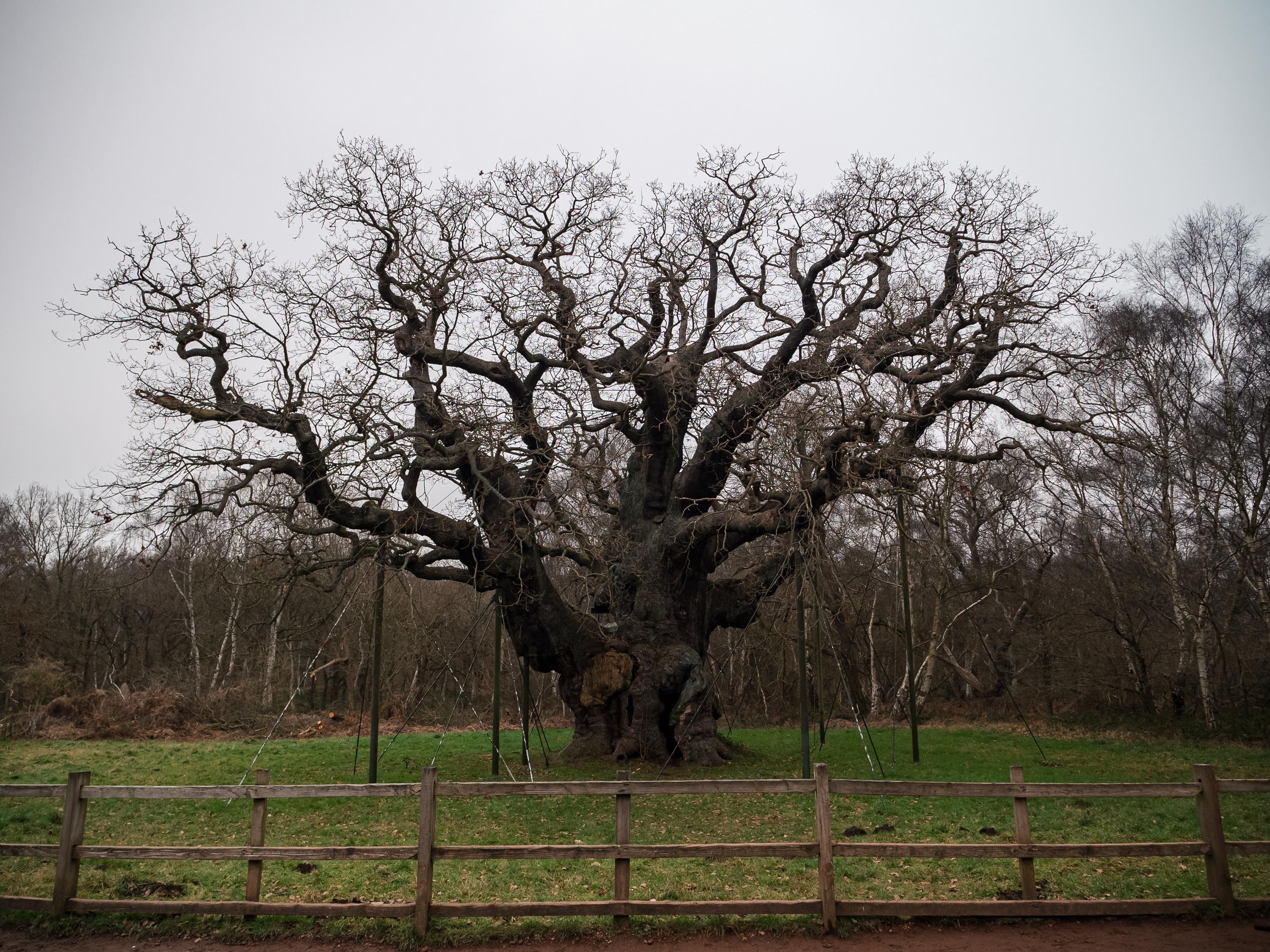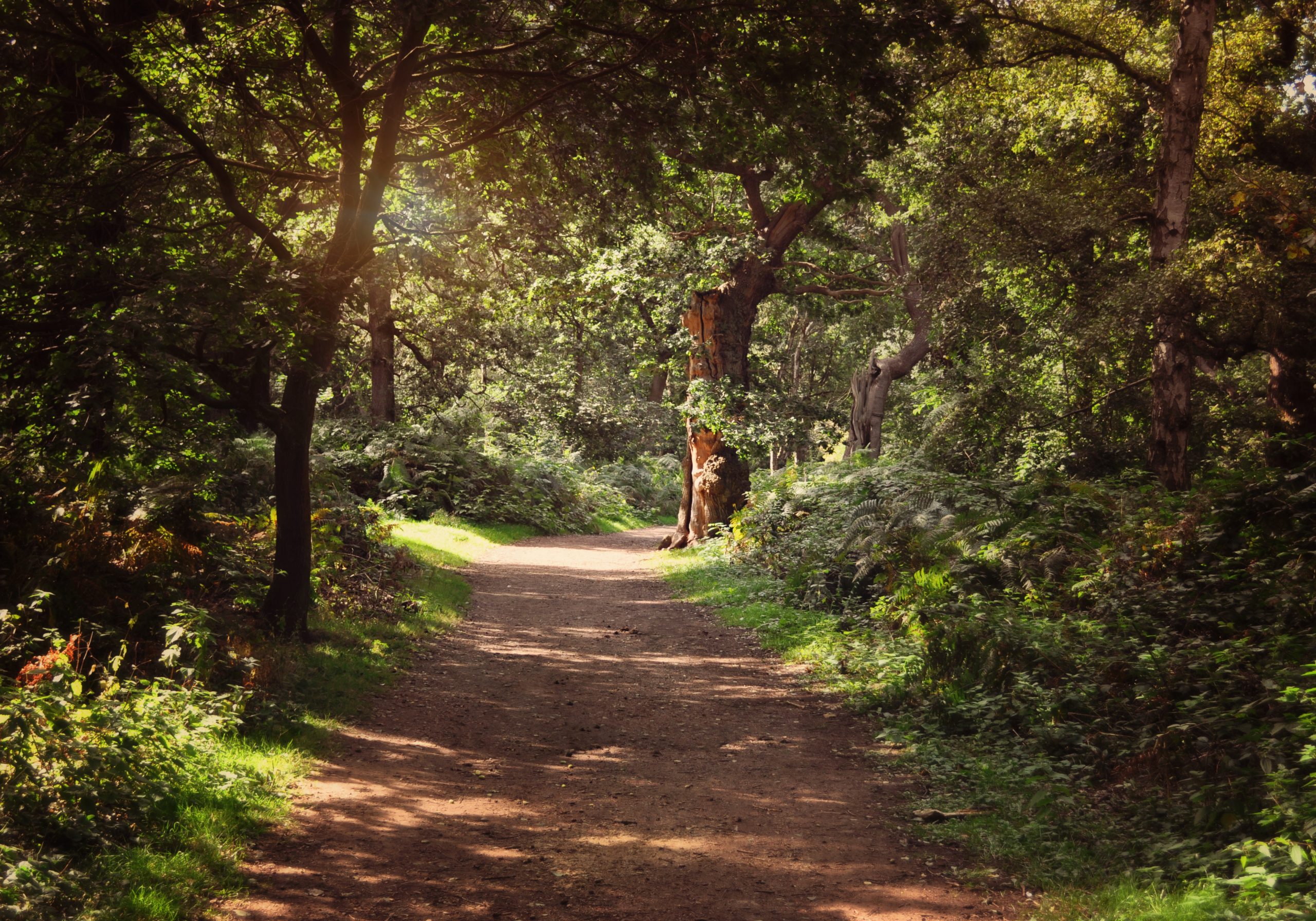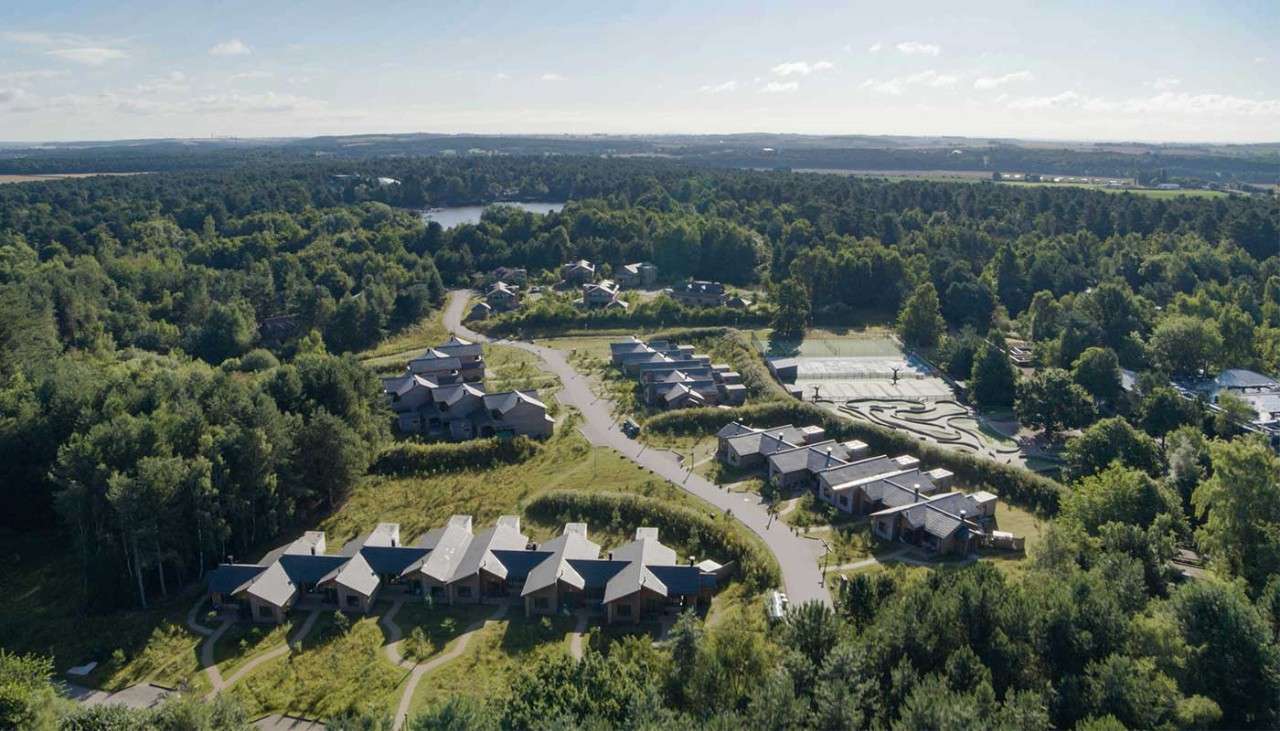Sherwood Forest
Sherwood Forest's Origins and History
Sherwood Forest is one of the most legendary and historic forests in England. Located in Nottinghamshire, the ancient forest was once a royal hunting ground and is famously associated with the legend of Robin Hood. Today, Sherwood Forest covers just over 1,000 acres and is a popular visitor attraction and recreational area. The name Sherwood comes from the Old English "scir wudu", meaning forest belonging to the shire or county. Some parts of the present forest date back to the end of the Ice Age 12,000 years ago. About 6,000 years ago, Neolithic farmers began clearing trees along the edges of the forest for agriculture. Sherwood has been part of a royal forest since at least the 11th century when it was set aside as a hunting area for the Anglo-Saxon kings. After the Norman conquest in 1066, Nottingham Castle and Sherwood Forest became a favoured hunting ground of the new aristocracy. King John would host great hunts in Sherwood that lasted for weeks at a time. The royal designation brought certain protections to the forest but also imposed harsh restrictions on the rights of local people living in nearby villages. It is this medieval history as part of the royal forest north of Nottingham that led to Sherwood's famous association with the heroic outlaw Robin Hood and his band of Merry Men who would poach the king's deer. While Robin Hood is a legendary figure with possible roots in actual outlaws or bandits of the 12th and 13th centuries, the earliest references to Robin Hood only date to the late 14th and 15th centuries. But over many centuries, Robin Hood has become an intrinsic part of Sherwood's mystique and renown around the world..
Major Sherwood Forest Attractions
As a visitor of Sherwood Forest today, the Major Oak tree is one of the most iconic attractions. Estimated to be over 800 years old, this ancient oak is said to have sheltered Robin Hood and his Merry Men. Its hollow trunk and massive limbs have amazed and inspired generations of Sherwood Forest visitors.
The Ancient Major Oak
The most legendary living resident of Sherwood Forest is the Major Oak, an astonishing tree estimated to be over 1,000 years old. This venerable giant envelops visitors in its shaded glade beside the main Sherwood Forest Visitor Centre, inviting generations to connect to the ancient history this tree has witnessed back through Saxon times when it was already a mature woodland patriarch. The Major Oak’s massive trunk measures over 36 feet around, supported by a complex skeleton of steel rails and posts to bear its enormous weight. Its series of far-reaching limbs span nearly 100 feet from end to end. Even in its elder years, this iconic oak supports a thick canopy of green leaves offering a shaded refuge reminiscent of the wooded protection this tree would have provided Robin Hood centuries past. Local tales recount this hollowed oak trunk concealing Robin Hood from the Sheriff’s searches. While the legendary outlaw is more fable than fact, majestic oaks like the Major Oak dominated Medieval Sherwood and could well have sheltered fugitives. Thus the Major Oak grows as a living artifact symbolising Sherwood’s endurance and the adventures of Robin Hood's enduring folk stories. Professional arborists carefully maintain the tree for longevity and visitor access with special padding around its base protecting the buttress roots from compaction. Duck boards further shield the entire root zone under the tree's broad spreading crown. Gentle pruning balances its energy while minimising the risk of limb loss. Fungicide applications foil infection to keep this beloved tree thriving. Thanks to protective measures the Major Oak continues hosting guests in its peaceful glade within the heart of the ancient Sherwood Forest.
The Legendary Larder Tree
Another plant protagonist in the Robin Hood legends of Sherwood is the gnarled oak stump known as the Larder Tree, rumoured to have been used by the outlaws to store poached venison and other game nicked from royal hunting preserves. The current tree is not the original which decayed away leaving only a hollowed trunk. But displays surrounding the erstwhile larder along a forest footpath recount traditional woodsman techniques for salting meats. The axe marks now visible in the remaining stump hint at the use of this aged oak as a secret forest pantry. Though the initial Larder Tree fell into ruin long ago, its massive stump survives in Sherwood Forest as a monument to the cunning ways Robin Hood's band of Merry Men evaded royal forest laws to sustain themselves in their woodland refuge through the harsh Medieval winters when royal hunting reserves gave poor peasants few options to feed their families. The present Larder Tree now flourishes for a new generation to appreciate Sherwood’s rich fables. While its folklore origins prove more fictitious than factual, this curious oak continues kindling visitors’ imaginations about the ancient woodland's role concealing Robin Hood from the Sheriff of Nottingham as one of England’s most enduring mythical heroes.
Major Oak & Visitor Centre
The iconic Major Oak stands as the crown jewel of the Sherwood Forest visitor complex, but the whole site welcomes tourists to explore exhibits and trails illuminating the ancient woodland’s natural splendour and legendary lore. Operated by the Royal Society for the Protection of Birds (RSPB), the Visitor Centre borders the heart of historic Sherwood Forest. Inside the timber lodge-style building, interactive displays highlight forest ecology, geologic history and efforts to conserve the delicate ecology that has prevailed since Sherwood Forest’s prehistoric origins. Kids clamber over climbers and play hunts for forest creatures in the nature discovery room. Cafes and a gift shop crammed with local crafts and Sherwood Forest souvenirs offer fuel for further exploration on meandering woodland paths under Sherwood's broadleaf canopy. The global fame of Sherwood Forest owes much to enduring myths of Robin Hood, and kids delight spotting statue depictions of Robin, Maid Marian and their Merry Men scattered throughout the forest gardens surrounding the visitor welcome centre. But interpretive signs also unpack realities behind the lore, profiling real Medieval outlaws and the royal forest laws that drove poaching and banditry in these primaeval woods. Whether your interests lie in legend or ecology, the Sherwood Forest Visitor Centre makes an essential launching point to uncover Sherwood’s natural and cultural treasures.
Edwinstowe Village
Neighbouring the main Sherwood Forest preserve the rural village of Edwinstowe charms visitors as the fabled site of Robin Hood’s wedding to Maid Marian in local mythology. HISTORIC St. Mary’s Church reputedly hosted their 14th-century nuptials. Today Edwinstowe village offers a pleasant jump to medieval times ambling its quaint lanes dotted with crooked half-timbered buildings, lively pubs and cute cafes ideal for a cream tea or meat pie pitstop. The Sherwood Forest Art and Craft Centre brings together local artists and food producers, while independent shops like the Junk & Disorderly vintage warehouse offer hunts for hidden gems. Grab a pint at the historic Dukeries Inn which has served wayward travellers since the 1600’s, then saunter through the village green’s Sherwood Forest-themed playground based on characters from the Robin Hood tales. Edwinstowe’s High Street hosts the annual Robin Hood Festival each August with costumed roleplayers, medieval wares, falconry displays and archery contests celebrating the village’s links to England’s most famous heroic outlaw legend. For enchanting rural hospitality and old community character right on the edge of mythic Sherwood Forest, visitors needn’t look farther than modest little Edwinstowe village.
Accommodations in the Sherwood Forest Area
Sherwood Forest offers a breadth of inviting places to rest and restore during your forest adventures. From luxury resorts and hotels to cosy rental cottages and campgrounds, visitors can select the perfect woodland lodging to match their interests and budgets. Top accommodation options include:
Luxury Amongst the Trees
Nestled within 28 pristine woodland acres neighbouring the ancient Major Oak itself, Centre Parcs Sherwood Forest treats guests to indulgent comfort integrated with tranquil forest wilderness through the trees all around. Visitors dwell in beautifully designed Scandinavian-inspired lodges and lushly vegetated neighbourhoods interlinked by footpaths untouched by vehicle traffic. From private hot tubs overlooking the forest to crackling fireplaces and plush beds, the luxury accommodation amenities set the stage for utter relaxation amid nature. But while peace pervades, excitement waits just out the door thanks to Centre Parcs Sherwood’s full program of family recreational activities from archery to kayaking and mountain biking trails to aerial rope courses. Back at your woodland lodge base, unwind tired muscles in your outdoor hot tub while watching evening descend on the forest. Then venture to the cheerful village square to enjoy live entertainment, shopping or dining out without even leaving the resort confines. With so much infrastructure taken care of on-site, Centre Parcs Sherwood Forest creates the perfect hassle-free headquarters in the woods for visitors to simply focus on creating unforgettable forest family memories to cherish always.
Old English Hospitality
On a charming 13th-century estate in Edwinstowe village, the Mercure Nottingham Sherwood Hotel extends warm hospitality in a historic countryside manor house setting surrounded by lush gardens and lawns. Just moments from Sherwood Forest’s legendary Major Oak and visitor complex, the country hotel’s 60 plush and contemporary guest rooms provide a peaceful escape to restore from days exploring Robin Hood’s stomping grounds. Dine on refined country cuisine made from fresh local fare in the critically acclaimed Buckthorne Restaurant situated in a former smithy on the property. In warmer months, the outdoor terrace makes an idyllic spot for casual lunches or afternoon tea under the spreading chestnut trees as birds chirp merrily all around on the rolling lawns. Guests also relish unwinding in the spa, indoor pool and well-equipped gym during their forest forays. For guests eager to further channel Medieval England, evenings feature live music echoing off the old timbered beams of the hotel’s Smoke Lounge bar—a perfect backstep in time to conjure Sherwood’s ancient folk legends from within their atmospheric forest setting.
Woodland Holiday Park
Affordable family fun awaits in Sherwood Forest itself at the Sherwood Forest Holiday Park bordering a protected woodland habitat frequented by native birds and wildlife. Visitors bunk in comfortably equipped timber lodges or modern caravans, with tent camping and glamping options like safari lodges and yurts also on offer. While self-catering units feature kitchens, the Boars Tavern pub provides classic English meals and hosts live evening bands during summer. Kids spread their wings in safety across the 20-acre park with playgrounds plus indoor games rooms and pools. Outside organised activities like woodland obstacle courses or talent contests build lasting memories. Families borrow bikes from the cycle hire shop or follow walking trails straight into the Major Oak’s forest from the holiday park nestled on Sherwood’s edge. Shuttle buses also quickly deliver guests to prime Robin Hood attractions like the Sherwood Forest visitor complex. Affordable rates, great amenities and the wooded wonder of Sherwood on the doorstep make the Sherwood Forest Holiday Park an ideal home base for cost-conscious travellers to experience the natural magic synonymous with Robin Hood adventures.
Sherwood Forest Center Parcs Resort
Set across more than 400 acres of preserved woodland and heath adjacent to legendary Sherwood Forest itself, the Sherwood Forest Center Parcs offers a luxury self-contained forest retreat. Owned by the same reputable company as the highly-rated neighbouring Centre Parcs, the Sherwood Forest Center Parcs provides a seamless hotel-style holiday for families. Guests lodge in beautiful, contemporary country cottages and villas integrated into the landscape, surrounded by nature’s peace yet with every desirable amenity close at hand. Though self-catering accommodations feature fully equipped kitchens and all the conveniences of home, visitors can still enjoy dining out without even leaving the park. The Foresters Restaurant prepares locally-sourced seasonal British cuisine alongside classic favourites while the country pub offers casual fare like wood-fired pizzas and an impressive range of UK real ales, stouts and ciders on tap. The on-site supermarket and other shops around the town square-inspired Plaza supply any household items needed during your stay. Guests also have use of a well-equipped gym, luxury spa and beauty salon throughout their forest foray.
Naturally, days fill easily with an abundance of activities available on the expansive Sherwood property. Adults challenge their skills on Europe’s largest high ropes courses set 30 feet high amidst woodland canopy while kids conquer mini versions catering to all ages and daredevil levels. Active older children flock to The Heights Centre featuring trapezes, ziplines, rock climbing walls, zorbing and mazes with nuevo circus workshops for trying new skills. When the weather keeps families inside, the arcade, bowling alley and pottery painting provide entertainment indoors. Yet Sherwood Forest Center Parcs never lets visitors forget the enchantment of the surrounding ancient woodlands. The grounds house preserves forest habitat for native wildlife like buzzards, woodpeckers, foxes, deer and badgers which lucky guests glimpsed on property rambles. The spa’s exclusive Serene Spa Garden immerses visitors in the therapeutic hush of nature at Sherwood Pines Forest Park after-hours while forest bathing experiences incorporate the sensory pleasures of the woods to create rejuvenating wellness rituals under the towering pines. Blending outdoor adventure and indulgent relaxation with luxury accommodation set amid protected woodland, Sherwood Forest Center Parcs promises a revitalising and memorable home base from which to explore Sherwood’s fairy tale scenery and famous folklore.
More Sherwood Forest Attractions and Activities
Beyond Sherwood Forest’s main claim to fame with the ancient Major Oak and central visitor complex, a wealth of other diversions await within the preserve and the surrounding region. Discover more enchanting Sherwood sights like:
Forest Rail Adventure
All aboard the Sherwood Forest Railway for a scenic ride through the ancient woodland’s natural splendour. This dedicated heritage railway transports visitors back in time aboard lovingly restored steam engines and classic diesel trains from the 1920s-60s. The railway was originally built nearly 150 years ago to connect local communities and serve Sherwood's coal mines. Today it erased modern world worries as riders admire sweeping forest vistas rolling by outside restored railway carriages with wooden bench seats or open viewing platforms. During the 40-minute forest circuit aboard the Sherwood Forest Railway, guides share stories of the rail route's history and folklore of Robin Southernwood haunts framed by the changing rural tableaus outside. Spot grazing deer, ponies and cattle dotting purple heather meadows and pine stands alongside the tracks. Kids wave at sheep and horses in fields skirting the railway. Special event days feature family activities like Easter egg hunts aboard the trains or pumpkin patches ripe for autumn picking after your ride through Sherwood's picturesque patchwork farmlands.Disembarking at the Sherwood Forest Railway's Jubilee Woodland Station, refresh yourself at the Engine Shed cafe before browsing the station shop filled with train-themed toys and local handicrafts. Panoramic verandas offer final photo-ops of the locomotive before it steams away into Sherwood's ancient forest taking a new round of passengers on this enduring rail journey back through railway heritage now intrinsically linked to Nottinghamshire’s wooded wonderland.
Pines Forest Recreation
Welcome to 3,500 acres of world-class mountain biking, walking trails and forest playgrounds within the sprawling Sherwood Pines Forest Park, just minutes from mythic Sherwood Forest's Major Oak yet wonderfully wild in its own right. As Britain's largest continuous forest region, the Pines protect rare lowland heath habitats. But outdoor enthusiasts flock here to charge down the forest’s purpose-built downhill mountain bike terrain and 19 miles of waymarked cycle tracks spanning green to black difficulty ratings through forest valleys and open heathland. Hikers admire the colourful carpet of heather blooming purple across the Sandy Lane heathland trail in late summer. Kids invent woodland fairy tales while navigating log piles and den to discover along the blue miniature trail. Parents pull tykes in trailers across the paved but twisty 7-mile family cycling loop known as the Sherwood Trail. Startling deer and occasional glimpses of shy adders thrill wildlife watchers traipsing slowly along the waymarked walking paths under Sherwood Pines’ canopy of Scots pine and silver birch. Back at the Visitor Centre, adventure seekers line up to clip onto high ropes courses threading through forest treetops. Inside, interactive exhibits showcase the working timber production side of Sherwood Pines balancing recreation access and economic forest use with habitat conservation. Just down the road lies Sherwood's world-famous ancient oaks and throngs tracing Robin Hood’s footsteps. But within Sherwood Pines Forest Park, rare wildlife and scenic vistas beckon visitors to discover this beloved public green playground scarcely less steeped in natural magic.
Majestic Manor House
Escape into the noble lifestyle of 19th-century aristocracy with a day visit to Thoresby Hall Hotel & Spa, an opulent stately home retaining the elegance of bygone eras on a sprawling country estate neighbouring Sherwood Forest. Today Thoresby Hall functions as a luxury hotel, but the public can still glimpse the refined architecture and decorative interior details of this 150-room manor house through regular heritage tours of the estate. Outdoors, over 2,500 acres of historic parklands, formal gardens, farmlands and pristine woodlands under the Thoresby Hall estate umbrella invite rambling on public footpaths and bridleways threading through a peaceful forest, sweeping lawns and colourful English cottage gardens. In the stables courtyard at the estate's heart, restaurants and boutiques like the Champagne & Chocolates Shop tempt visitors to prolong their aristocratic sojourn. Browse the craft fair under the soaring Victorian glass conservatory then stroll to the orangery café or woodland play zone to pass an idyllic afternoon on noble rural lands bordering the ancient oaks of legendary Sherwood itself. With accommodations set right within one of Nottinghamshire's grandest manors, the hotel extends guests every modern indulgence from fine dining to the spa. Yet the original period architecture immortalising 19th-century elite country life amidst Sherwood Forest’s timeless natural splendour still captivates the imagination during even brief visits to the majestic Thoresby Hall estate.
Sherwood Forest Wildlife Habitats and Conservation
As one of England's most treasured wooded landscapes, Sherwood Forest provides an important wildlife habitat and ecosystem. While the forest itself covers just over 1000 acres, Sherwood sits within a larger ring of protected conservation woodlands. Collectively known as the Sherwood Forest National Nature Reserve (NNR), these preserved lands not only safeguard Sherwood's ancient oaks and delicate woodland flora but also provide refuge for an array of native birds and mammals. The mix of oak and birch wood pasture along with purple moor grassland and heathland found in Sherwood NNR supports threatened bird species like hawfinches, marsh tits, nightjars, and honey buzzards along with tawny owls, sparrowhawks, hobbies and all three British woodpecker species. To help conserve habitat for the black grouse, 46 hectares of heathland were restored near Sherwood in 1992. Heathland restoration work continues, aimed at protecting rare butterflies like the black hairstreak and vulnerable reptiles including adders and grass snakes that dwell in the forest's sandy soils. Recent wildlife monitoring data shows stable or increasing populations of adders, common lizards and nesting birds like woodlarks thanks to these habitat management efforts within Sherwood Forest NNR.
Responsible public access paired with habitat protection allows people to better appreciate Sherwood’s natural heritage through low-impact activities such as walking forest footpaths to admire flowers like bluebells in spring or evening forest bat walks to witness nocturnal woodland creatures. Guided tours on themes like the ancient trees of Sherwood highlight forest ecology and efforts to carefully guard treasures like the Major Oak against threats from pests, pathogens or overenthusiastic tourists. With support from conservation charities like the RSPB and Nottinghamshire Wildlife Trust along with continued monitoring and maintenance from government bodies like National England, the future looks hopeful that the Sherwood Forest ecosystem will endure for future generations to experience. From veteran oaks to rare butterflies to nesting sparrowhawks, the diverse plants and animals of Sherwood NNR will continue dwelling in this legendary landscape.
Robin Hood Legends and Sherwood Forest Lore
For over 800 years, Sherwood Forest has captured the popular imagination as the symbolic home of Robin Hood and his band of noble outlaws who poached the king's deer while evading capture in this thick woodland refuge. While the tales of Robin Hood contain more fantasy than fact, kernels of truth exist at the core along with tangible remnants still evident in Sherwood Forest today. The earliest written references to a Robin Hood or "Robyn Hode" figure appear in 1377 as a general term for criminals or outlaws. But within 100 years, stories began emerging of Robin Hood as a dispossessed Saxon nobleman who, after the Norman conquest of 1066, was forced into outlawry in Sherwood Forest.
In these early tales, Robin Hood is portrayed as an anti-establishment figure defending ordinary citizens against injustice and elite oppression. As the Robin Hood legend evolved, the outlaw Robin became known for robbing the rich, giving to the poor and evading corrupt authorities thanks to refuge in Sherwood's thick forests and the loyal support of common folk. Though works of fiction, the many re-tellings of the Robin Hood legend highlight Sherwood as a place of refuge and resistance against tyranny. The Major Oak stands as a living artefact from Robin Hood's era that connects visitors to the potency the landscape once held in sheltering outlaws from preferential forest laws among other injustices faced by Medieval peasants and yeomen. Tangible traces of encampments and zig-zagging Medieval forest pathways offer glimpses of how Sherwood Forest sustained and concealed generations of outlaws, poachers and bandits before Robin Hood tales were widespread. Ancient place names like Robin Hood's Larder Tree or Robin's Hideout Field capture folklore of Sherwood as the elusive hideaway central to the enduring Robin Hood myths.
Visiting Sherwood Forest today offers a portal into the past woods that so famously sheltered Robin Hood from the Sheriff of Nottingham according to enduring legend. More than any single piece of evidence, it is Sherwood's overall ambience transporting visitors back to a lawless age that makes it easy to imagine Robin Hood emerging from behind one of Sherwood’s aged oaks.

Let us know you agree to cookies
We use marketing, analytical and functional cookies as well as similar technologies to give you the best experience. Third parties, including social media platforms, often place tracking cookies on our site to show you personalised adverts outside of our website.
We store your cookie preferences for two years and you can edit your preferences via ‘manage cookies’ or through the cookie policy at the bottom of every page. For more information, please see our cookie policy.








